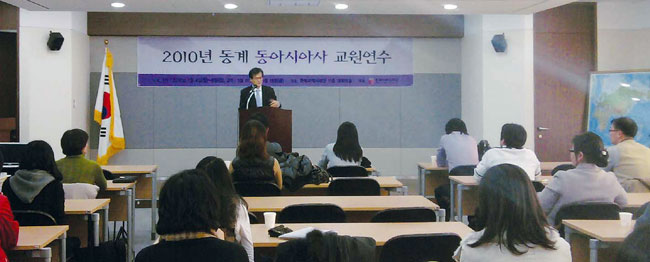동북아역사재단 2010년 03월호 뉴스레터
- Lee, Young-hwa / Teacher, Jowon Middle School in Suwon
Dec. 17, 2009 was a very historic day for history teachers in schools. This is because in defiance of earlier expectation the 'East Asia History' was adopted as the history sbubject instead of 'Korean Culture History' in the revision of educational process for 2009. The controversial educational process has yet to be tested regarding its worthiness and meaning in our history education. But it is fortunate to see the 'East Asia History' came to remain afloat though it had been put on the brink of disappearance.
But as for on-site history teachers, 'East Asia History' has been a very strange and unprecedented subject. As most teachers are accustomed to the hierarchy and order of the knowledge of the 'Oriental History,' many cast doubts whether they will be able to teach students appropriately as the East Asia History, which has recently emerged as a new history theme, lacks accumulated knowledge and studies.

The training kicked off in the first week of January of 2010, when there was a record heavy snow in 100 years, in strenuous efforts to find feasible solution to the questions. The sessions, in particular, provided in-depth training course and the participants' maintained fervent attitudes in token of gratitude for the sincerity of the foundation which organized the event.
The training session ran 15 days in Seoul and Busan. The 10 subjects broke down to as follows. The first and last lectures shed lights on historical conflicts and efforts toward reconciliation with focus on the background of the adoption of the 'East Asia History.' The lectures underlined the fact that 'East Asia History' will be able to resolve the chronic problems arising from hitherto Oriental history education centered around the histories of Japan and China. Other lectures dealt with issues and subjects that have never been addressed by relevant teachers to provide them with further chances to have easier access to the issues.
So far we took it for granted to regard history with a belonged nation as a unit like 'Korean history for Koreans,' 'Chinese history for Chinese' and 'Japanese history for Japanese.' But the recent emergence of debate on the possible creation of East Asia community has prompted the need to look back on the properness of the history approach. The historical adoption of the 'East Asia History' was made possible as a consequence of such efforts. But questions continue to linger on the lack of concrete pictures and details of historical space and boundaries in the absence of academic foundation for the new subject. It is a matter of ''Is it possible to teach history without the support from historical studies?"
We could find a solution to the questions while receiving training for the history teachers. The answer was very 'simple' contrary to expectation. Though it is difficult to show the students fixed and agreed aspect of 'East Asia History,' it is possible to provide them with 'East Asian' education through which they can acquire way of thinking and viewpoint from an East Asian perspective. Though it will be a difficult mission for the history teachers, the 'East Asia History' will surely be a method of history education toward enhancing historical thinking power for the students.
The East Asian perspectives will provide students with capabilities to see history from various angles rather than a certain forced one. They will be able to look into things from perspectives from both ours and others and society and history from the East Asian viewpoints, thus being capable of looking back on their own judgment.
The winter training was a very meaningful session that provided history teachers with precious chances to feel the dire need for the 'East Asia History.' I believe it is one of the foundation's major tasks to offer such programs for both teachers and students so that they can play their roles of teaching and learning the East Asia history on the site.


